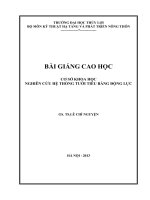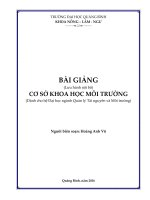Bài giảng Cơ sở khoa học của biến đổi khí hậu (Đại cương về BĐKH) – Phần II: Bài 9 – ĐH KHTN Hà Nội
Bạn đang xem bản rút gọn của tài liệu. Xem và tải ngay bản đầy đủ của tài liệu tại đây (10.41 MB, 19 trang )
VNU HANOI UNIVERSITY OF SCIENCE
REGIONAL CLIMATE MODELING AND CLIMATE CHANGE
CƠ SỞ KHOA HỌC
CỦA BIẾN ĐỔI KHÍ HẬU
(Đại cương về BĐKH)
Phần II
----------------------------------------------------------Phan Van Tan
B09: Biến đổi của các hiện tượng cực đoan
Bài 1: Các thành phần của hệ thống khí hậu
Bài 2: Sự truyền bức xạ và khí hậu
Bài 3: Hồn lưu khí quyển và khí hậu
Bài 4: Bề mặt đất, Đại dương và khí hậu
Bài 5: Lịch sử và sự tiến triển của khí hậu Trái đất
Bài 6: Khái niệm về Biến đổi khí hậu
Bài 7: Tác động bức xạ và BĐKH
Bài 8: Biến đổi trong các thành phần của hệ thống khí hậu
Bài 9: Biến đổi của các hiện tượng cực đoan
Bài 10: Giới thiệu về khí hậu Việt Nam
Bài 11: Biến đổi khí hậu ở Việt Nam
Bài 12: Mơ hình hóa khí hậu
Bài 13: Dự tính khí hậu
Bài 14: Xây dựng kịch bản BĐKH
Bài 15: Tác động của BĐKH và tính dễ bị tổn thương do BĐKH
BĐKH và các hiện tượng cực đoan
• Biến đổi khí hậu dẫn đến sự
tăng giá trị trung bình hoặc
phương sai hoặc cả hai, và
do đó làm gia tăng các hiện
tượng cực đoan
Dao động khí hậu và các hiện tượng cực đoan
| Dao động khí
hậu trên quy mơ
thời gian hàng
chục nghìn năm:
{ Chu kỳ
Milankovich:
~100.000 năm
| Xu thế:
{ Tăng: Băng hà
à Gian băng
{ Giảm: Gian
băng à Băng
hà
Dao động khí hậu và các hiện tượng cực đoan
| Dao động khí hậu trên
quy mơ thời gian ngắn
(dưới 10 năm):
{ Chu kỳ ENSO: ~2-8
năm
| Biên độ dao động có
thể bị biến đổi
{ Biên độ tăng: Làm
gia tăng hiện tượng
cực đoan
| Khơng xác định xu
thế vì thời gian q
ngắn
Dao động khí hậu và các hiện tượng cực đoan
| Trong một chu kỳ dao động khí hậu dài năm (hàng nghìn
năm hoặc hàng chục nghìn năm) có thể có các giai đoạn
(hàng thế kỷ) trong đó khí hậu có xu thế nóng lên hoặc
lạnh đi
{ Trong dao động có biến đổi
| Trong một giai đoạn đủ dài mà khí hậu đang có xu thế
nóng lên hoặc lạnh đi, khí hậu có thể dao động lên
xuống
{ Trong biến đổi có dao động
| Khi đang trong quá trình biến đổi của khí hậu, dao động
khí hậu có thể làm gia tăng các cực trị khí hậu è Gia
tăng các hiện tượng cực đoan (do gia tăng biên độ
dao động)
Các chỉ số khí hậu cực đoan
Box 2.4, Table 1 | Definitions of extreme temperature and precipitation indices used in IPCC (after Zhang e
may be shown as normalized or relative depending on application in different chapters.
Định nghĩa các chỉ số nhiệt và mưa cực đoan sử dụng trong IPCC
Index
Descriptive name
Definition
Units
TXx
Warmest daily Tmax
Seasonal/annual maximum value of daily maximum
temperature
ºC
Bo
10
TNx
Warmest daily Tmin
Seasonal/annual maximum value of daily minimum
temperature
ºC
Fig
TXn
Coldest daily Tmax
Seasonal/annual minimum value of daily maximum
temperature
ºC
Fig
TNn
Coldest daily Tmin
Seasonal/annual minimum value of daily minimum
temperature
ºC
Fig
TN10p
Cold nights
Days (or fraction of time) when daily minimum
temperature <10th percentile
Days (%)
Fig
Ta
TX10p
Cold days
Days (or fraction of time) when daily maximum
temperature <10th percentile
Days (%)
Fig
TN90p
Warm nights
Days (or fraction of time) when daily minimum
temperature >90th percentile
Days (%)
Fig
Ta
TX90p
Warm days
Days (or fraction of time) when daily maximum
Days (%)
Fig
temperature <10th percentile
Tab
Các chỉ số khí hậu cực đoan
TX10p
Cold1days
(or fraction
of precipitation
time) when daily
maximum
Days (%)
Box
2.4, Table
| Definitions of extreme Days
temperature
and
indices
used in IPCC (after
ZhangFiget
temperature
percentile
may be shownĐịnh
as normalized
or chỉ
relative
depending
on <10th
application
in different
chapters.
nghĩa các
số nhiệt
và mưa
cực đoan
sử
dụng trong
IPCC
TN90p
Index
Warm nights
Descriptive name
Days (or fraction of time) when daily minimum
temperature >90th Definition
percentile
Days (%)
Units
Fig
Tab
TXx
TX90p
Warmest
daily Tmax
Warm days
Seasonal/annual
valuedaily
of daily
maximum
Days (or fraction maximum
of time) when
maximum
temperature >90th percentile
ºC(%)
Days
Box
Fig
10.
Tab
TNx
FD
Warmest
Frost daysdaily Tmin
Seasonal/annual
of daily minimum
Frequency of dailymaximum
minimumvalue
temperature
<0°C
temperature
ºC
Days
Figu
Fig
Tab
TXn
TR
Coldest
Tropical daily
nightsTmax
ºC
Days
Figu
Fig
RX1day
TNn
Wettest day
Coldest daily Tmin
mm
ºC
Fig
Figu
Tab
RX5day
TN10p
Wettest consecutive five days
Cold nights
mm
Days (%)
SDII
TX10p
Simple daily intensity index
Cold days
Fig
Figu
Tab
Fig
Figu
R95p
TN90p
Precipitation from very wet
Warm
days nights
CDD
TX90p
Consecutive dry days
Warm days
Seasonal/annual
of daily maximum
Frequency of dailyminimum
minimumvalue
temperature
>20°C
temperature
Maximum 1-day precipitation
Seasonal/annual minimum value of daily minimum
temperature
Maximum of consecutive 5-day precipitation
Days (or fraction of time) when daily minimum
temperature <10th percentile
Ratio of annual total precipitation to the number of
Days
(or fraction
wet days
(≥1 mm)of time) when daily maximum
temperature <10th percentile
Amount of precipitation from days >95th percentile
Days (or fraction of time) when daily minimum
temperature >90th percentile
Maximum number of consecutive days when
Days
(or fraction
of time) when daily maximum
precipitation
<1 mm
temperature >90th percentile
FD
Frost days
Frequency of daily minimum temperature <0°C
mm day–1
Days (%)
mm
Days (%)
Days
Days (%)
Days
Fig
Figu
Tab
Tab
Fig
Figu
Tab
Figu
Một số nhận định từ AR4
| Từ 1950, số lượng sóng nóng tăng lên, và số lượng các đêm
|
|
|
|
nóng tăng phổ biến
Phạm vi các khu vực chịu tác động của hạn hán cũng tăng
lên vì giáng thủy trên đất liền giảm trong khi bốc hơi tăng do
nhiệt độ tăng nhiều hơn
Số sự kiện giáng thủy ngày lớn (nguyên nhân gây lũ lụt) tăng
lên, nhưng không phải ở mọi nơi
Tần suất xoáy thuận nhiệt đới và bão biến động lớn từ năm
này sang năm khác. Có bằng chứng cho thấy sự tăng đáng kể
về cường độ và thời gian hoạt động kể từ những năm 1970
Ở các vùng ngoại nhiệt đới, biến động về quĩ đạo và cường
độ bão phản ánh sự biến động của hồn lưu khí quyển, như
dao động Bắc Đại Tây dương (NAO)
Một số nhận định từ AR4
| Biến đổi của loại, tần suất và cường độ của các sự kiện
cực trị có thể là hệ quả của những biến đổi của khí hậu
Trái đất,
| Sự biến đổi này có thể xuất hiện thậm chí cả với những
biến đổi tương đối nhỏ của khí hậu trung bình
| Những biến đổi của một vài loại sự kiện cực trị đã từng
được quan trắc thấy, ví dụ sự tăng tần suất và cường độ
của các sóng nóng và những sự kiện giáng thủy lớn
Biến đổi của cực đoan nhiệt độ
Hàm phân bố xác suất năm của các chỉ số nhiệt độ cho 202 trạm trên
tồn cầu có ít nhất 80% số liệu giai đoạn 1901-2003 của ba thời kỳ:
Observations:
and Atmospheric
ClimateTrục
Change
1901 - 1950 (black), 1951 - 1978
(blue) Surface
và 1979
- 2003 (red).
hoành là % số năm với ngưỡng đêm lạnh là phân vị 10% và đêm ấm
là phân vị 90% (IPCC, 2007).
Cold
nights
decreased,
Warm
nights
increased
Figure 3.38. Annual
probability
distribution
functions for
temperature
indices for
202 global stations with at
least 80% complete data between 1901 and 2003 for three time periods: 1901 to 1950 (black), 1951 to 1978
Biến đổi của cực đoan nhiệt độ
Phân bố dị thường nhiệt độ cực
tiểu ngày (a) và cực đại ngày (b)
so với thời kỳ 1961-1990 cho hai
giai đoạn: 1951–1980 (blue) và
1981–2010 (red) sử dụng số liệu
HadGHCND.
Màu đậm hơn biểu thị số ngày
và đêm lạnh nhất đã giảm (màu
xanh đậm) và số ngày và đêm
nóng/ấm nhất đã tăng (màu đỏ
sẫm) trong giai đoạn 1981-2010
so với giai đoạn 1951-1980
Biến đổi của cực đoan nhiệt độ
Xu thế tần suất năm của nhiệt độ cực trị
thời kỳ 1951–2010 đối với:
(a) cold nights (TN10p),
(b) cold days (TX10p),
(c) warm nights (TN90p) and
(d) warm days (TX90p).
Grey areas indicate incomplete or missing data.
Black plus signs (+) indicate grid boxes where
trends are significant. The near-global time series
of annual anomalies of these indices with respect
to 1961–1990 (IPCC, 2013)
• The numbers of cold days and nights have
decreased and the numbers of warm days
and nights have increased overall on the
global scale
• Such changes have also occurred across
most of North America, Europe, Asia and
Australia
• The length and frequency of warm spells,
including heat waves, has increased since
the middle of the 20th century
• Heatwave frequency has increased in large
parts of Europe, Asia and Australia
middle
increases
of the
20th
inthe
indices
doubling
of extremes
warm
ofofthe
extremes,
occurrence
since
ofextremes
warm
the middle
and
a of
halving
the 20th
of
thedoubling
of the ex
majority
of that
warm
and
cool
show
warming
in
temperature
extremes
(Barrucand
eo
dence
majority
warm
and cool
show
warming
inoccurrence
temperature
addition,
century,
globalconsistent
of cold
with
nights,
warming
for example,
of the climate.
parts of
In the
addition,
Asia-Pacific
global-region
of cold
(Choinights,
et fo
remains
high.
ted increases
ly averaged
over multi-day
al., 2009)
heat
andevents
parts had
of Eurasia
likely exhibited
(Klein Tank
increases
et al., over
2006; Donat
al., 2009)
et al.,and pa
Trend estimates and 90% confidence intervals for global values of cold nights
imilar
aTable
conclusions
similar
period.
2013a,
SREX
2013c)
updated
since
AR4
the
mid-20th
came
to(Box
century.
Changes
conclusions
incold
both
local
2013c)
and
d estimates
and2.12
90%
intervals
2.2)
forbut
global
values
ofsimilar
cold
(TN10p),
days
(TX10p),
warmsin
n
| confidence
Trend
estimates
and (Box
90%
confidence
intervals
2.2)nights
for
global
values
of 2013a,
cold
nights
(TN10p),
(TN10p), cold days (TX10p), warm nights (TN90p) and warm days (TX90p) over the
951–2010
(see
Box
2.4,
Table
1 for(Section
more
on
overand
the1979–2010
periods
1951–2010
and
1979–2010
(seeinformation
Box2.4.2)
2.4, Table
1indices).
for more
information
indices).
Seneviratne
while
et
using
al., the
global
revised
SST
AR5
patterns
uncertainty
guidance
and
(Seneviratne
large
scale
etcirculation
al., onglobal
patterns
SST pattern
periods
1951–2010
and 1979–2010
he level
2012).
of confiFurther (Section
evidence2.7)
since
have
then
been
indicates
shown to
that
be the
associated
level ofwith
confiregional
(Section
changes
2.7) have
Trends in % per d
Trends in % per decade
es show
dence
warming
that theinmajority
temperature
of warm
extremes
and cool
(Barrucand
extremeset show
al., 2008;
warming
Scaife et
in al.,
temperature
2008;
ex
Data SetTN10p
TN10p TX10p
TX10p TN90p
Set
remains high.
Biến đổi của cực đoan nhiệt độ
1951–2010
1951–2010
1979–2010
1951–2010
1979–2010
1951
1979–2010
1951–2010
1979–2010
1951–2010
1979–2010
x 2.2)
for
Table
global
2.12
values
ofal.,
cold
estimates
nights–4.2
(TN10p),
and±90%
intervals
nights
2.2)± for
(TN90p)
global
values
warm
of –4.1
cold
days±nights
(TX90p)
(TN10p),
HadEX2
(Donat
et
2013c)
–3.9
±confidence
0.6days
–4.2warm
±(Box
1.2–4.1
–2.5
± 0.7and
1.4 6.8
al.,
2013c)
–3.9| ±Trend
0.6
1.2 cold
–2.5 (TX10p),
± 0.7
1.4
4.5 ±
0.9
± 1.84.5
e 1 for more
over information
the periods 1951–2010
on indices). and 1979–2010 (see Box 2.4, Table 1 for more information on indices).
HadGHCND
–3.3 ± 0.8 5.8 ± 1.3 –5.0 ± 1.6 8.6 ± 2.35.8
r et al., 2006)
–4.5(Caesar
± 0.7 et al., 2006)
–4.0 ± –4.5
1.5 ± 0.7–3.3 ± 0.8 –4.0 ± 1.5–5.0 ± 1.6
GHCNDEX
(Donat
al., 2013a)
± 0.6–2.6 ± 0.7 –3.9 ± 1.3–3.9 ± 1.4
–2.6 ± 0.7 4.3 ± 0.9 Trends
–3.9 ± 1.4in6.3
et al., 2013a)
–3.9
± 0.6et
± –3.9
1.3decade
1.84.3d
Trends
in–3.9
% per
%±per
10
TX10p
Data Set
1951–2010
1979–2010
TN90p
TN10p
TX90p
TX10p
1951–2010
1979–2010
1979–2010
1951–2010
1979–2010
1951
2
–2.5
HadEX2
± 0.7(Donat et al.,
–4.1
2013c)
± 1.4
–3.9
4.5 ±±0.9
0.6
–4.2
6.8 ±±1.8
1.2
–2.5
2.9 ±± 1.2
0.7
–4.1
6.3 ±± 2.2
1.4
4.5
5
–3.3
HadGHCND
± 0.8 (Caesar–5.0
et al.,
± 2006)
1.6
–4.5
5.8 ±±1.3
0.7
–4.0
8.6 ±±2.3
1.5
–3.3
4.2 ±± 1.8
0.8
–5.0
9.4 ±± 2.7
1.6
5.8
3
–2.6
GHCNDEX
± 0.7 (Donat et–3.9
al., ±
2013a)
1.4
–3.9
4.3 ±±0.9
0.6
–3.9
6.3 ±±1.8
1.3
–2.6
2.9 ±± 1.2
0.7
–3.9
6.1 ±± 2.2
1.4
4.3
209
Biến đổi của cực đoan nhiệt độ
| Từ khoảng 1950 rất có thể số ngày lạnh và đêm lạnh đã
giảm và số ngày nóng và đêm ấm đã tăng trên quy mơ
tồn cầu
| Có khả năng những biến đổi như vậy cũng đã xảy ra trên
hầu khắp Bắc Mỹ, châu Âu, châu Á và Australia
| Với độ tin cậy trung bình, nói chung trên tồn cầu độ dài
và tần suất của các đợt nóng, bao gồm cả sóng nhiệt, đã
tăng lên từ giữa thế kỷ 20 mặc dù nhiều khả năng trong
giai đoạn này tần suất sóng nhiệt đã tăng lên trên phần
lớn diện tích Châu Âu, Châu Á và Australia
Biến đổi của cực đoan giáng thuỷ
• Increases in the number of
heavy precipitation events
since 1951 in more regions,
but there are strong regional
and sub-regional variations
in the trends.
• The overall most consistent
trends towards heavier
precipitation events are
found in central North
America (very likely
increase) but assessment for
Europe shows likely
increases in more regions
than decreases
Trends in (a) annual amount of precipitation from days >95th percentile (R95p), (b) daily precipitation
intensity (SDII) and (c) frequency of the annual maximum number of consecutive dry days (CDD). Grey
areas indicate incomplete or missing data. Black plus signs (+) indicate grid boxes where trends are
significant. (d) Trends (normalized units) in hydroclimatic intensity (HY-INT: a multipli- cative measure of
length of dry spell and precipitation intensity) over the period 1976–2000. An increase (decrease) in HY-INT
reflects an increase (decrease) in the length of drought and /or extreme precipitation events
Biến đổi của cực đoan khác
| Floods:
{ Although the most evident flood trends appear to be in northern high
latitudes, in some regions no evidence of a trend in extreme flooding has
been found
| Droughts:
{ It is likely that the frequency and intensity of drought has increased in the
Mediterranean and West Africa and decreased in central North America and
north-west Australia since 1950
| Severe Local Weather Events:
{ There is low confidence in observed trends in small-scale severe weather
phenomena such as hail and thunderstorms because of historical data
inhomogeneities and inadequacies in monitoring systems
| Tropical Storms:
{ It is unlikely that Annual numbers of tropical storms, hurricanes and major
hurricanes counts have increased over the past 100 years in the North
Atlantic basin
{ Evidence, however, is for a virtually certain increase in the frequency and
intensity of the strongest tropical cyclones since the 1970s in that region
Biến đổi của cực đoan khác
Normalized 5-year running means of the
number of
(a) adjusted land falling eastern Australian
tropical cyclones and
(b) unadjusted land falling U.S. hurricanes
and
(c) land-falling typhoons in China
Vertical axis ticks represent one standard
deviation, with all series normalized to unit
standard deviation after a 5-year running
mean was applied.
Tóm tắt
Xu thế tần suất
(hoặc cường độ)
của các cực đoan
khí hậu khác
nhau (hướng mũi
tên chỉ xu thế
biến đổi) từ giữa
thế kỷ 20 (trừ
bão Bắc Đại Tây
dương mà thời
kỳ khảo sát là từ
những năm
1970)









